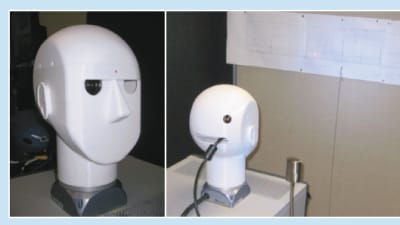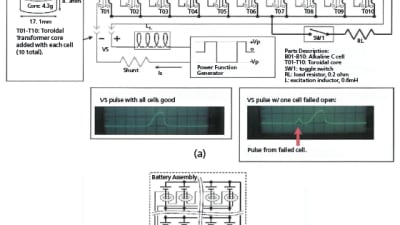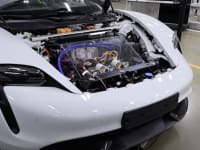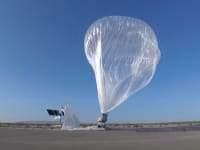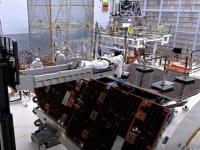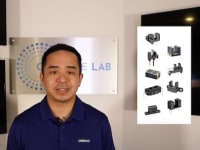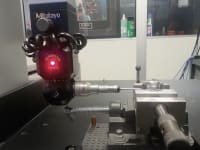61
169
-1
4770
30
Briefs: Mechanical & Fluid Systems
The device and method are used to quantify end-to-end latency of head- or helmet-mounted display with head tracking systems in a laboratory or in situ. All commercial or custom head-mounted display...
Briefs: Mechanical & Fluid Systems
Workspace-Safe Operation of a Force- or Impedance-Controlled Robot
Precise motion control of a robot by controlling its various robotic manipulators may be organized by the required level of task specification. The levels include object-level control, which describes the ability to control the behavior of an object held in a single or a cooperative...
Briefs: Mechanical & Fluid Systems
Cryogenic Mixing Pump with No Moving Parts
Refueling spacecraft in space offers tremendous benefits for increased payload capacity and reduced launch cost, but the problem of thermal stratification in long-term storage tanks presents a key challenge. To meet this challenge, a reliable, compact, lightweight, and efficient cryogenic mixing pump was...
Briefs: Mechanical & Fluid Systems
Seal Design Feature for Redundancy Verification
NASA has requirements for redundant seals to protect human-occupied cabin atmospheres, as well as fluid and gas systems in space vehicles exposed to the harsh environments. Comparable requirements have been passed down to the International Space Station (ISS) Program, and are now levied on the Orion...
Briefs: Mechanical & Fluid Systems
Dexterous Humanoid Robot
A humanoid robot has been created that includes a torso, a pair of arms, a neck, and a head. The torso extends along a primary axis and presents a pair of shoulders. The pair of arms movably extends from the shoulders. Each of the arms is fully jointed. The neck movably extends from the torso along the primary axis, and has...
Briefs: Mechanical & Fluid Systems
Tethered Vehicle Control and Tracking System
This innovation can control the flight of a tethered vehicle, in an airborne wind energy (AWE) generation system, through the use of a pan-tilt platform and a visible spectrum digital camera, combined with tracking and control software running on a standard PC.
Briefs: Physical Sciences
Lunar Organic Waste Reformer
The Lunar Organic Waste Reformer (LOWR) is a novel technology to convert organic wastes from human space exploration outposts into useful propellant constituents. The LOWR meets NASA’s Trash to Supply Gas (TtSG) objective under the Advanced Exploration Systems Logistics Reduction and Repurposing project by integrating...
Briefs: Physical Sciences
Digital Laser Frequency Stabilization via Cavity Locking Employing Low-Frequency Direct Modulation
This project’s goal was to simplify laser frequency stabilization. A simpler system will have many benefits, including reduction of power consumption, complexity, volume, mass, and risk of failure. To implement the Pound-Drever-Hall (PDH) technique...
Briefs: Physical Sciences
Deep UV Discharge Lamps in Capillary Quartz Tubes with Light Output Coupled to an Optical Fiber
Researchers at Jet Propulsion Laboratory have come up with a novel approach to the simplification of the 194-nm light source and optical guidance in mercury trapped ion spectroscopy research. Mercury plasma is generated in a capillary tube with a...
Briefs: Physical Sciences
Speech Acquisition and Automatic Speech Recognition for Integrated Spacesuit Audio Systems, Version II
Astronauts suffer from poor dexterity of their hands due to the clumsy spacesuit gloves during Extravehicular Activity (EVA) operations, and NASA has had a widely recognized but unmet need for novel human-machine interface technologies to...
Briefs: Physical Sciences
Advanced Sensor Technology for Algal Biotechnology
Advanced Sensor Technology for Algal Biotechnology (ASTAB) is an integrated package of water quality and algal physiology sensors designed to enable algae growers to increase significantly productivity and efficiency of their operations, optimize harvesting periods, and avoid losses of...
Briefs: Physical Sciences
High-Speed Spectral Mapper
The Hyperspectral Infrared Imager (HyspIRI) spaceborne mission has two imaging sensors operating in the visible to shortwave infrared (VSWIR) and the thermal infrared (TIR), respectively. The HyspIRI-TIR imaging instrument is being developed for infrared mapping of the Earth in 8 spectral bands with a 5-day revisit time...
Briefs: Information Technology
“Ascent - Commemorating Shuttle” — A NASA Film and Multimedia Project DVD
NASA seeks to preserve, and make readily accessible, historical Space Shuttle launch footage to inspire and educate NASA stakeholders both in and outside the NASA family through the dissemination of the Ascent production materials as a DVD, and through both NASA...
Briefs: Information Technology
High-Pressure, Reduced-Kinetics Mechanism for N-Hexadecane Oxidation
Combustion of realistic fuels is described by thousands of reactions involving thousands of species. Coupling these detailed chemical mechanisms with turbulence simulations is completely impractical because there is no computer powerful enough to solve the resulting equations.
Briefs: Information Technology
Method of Error Floor Mitigation in Low-Density Parity-Check Codes
Low-density parity-check (LDPC) codes often suffer from an “error floor” in which increasing signal-to-noise ratios do not lead to substantially better error rate performance. Error floors of LDPC codes are often not an inherent problem of the code design, but rather, a...
Briefs: Information Technology
X-Ray Flaw Size Parameter for POD Studies
Nondestructive evaluation (NDE) method capability is determined by a statistical flaw detection study called probability of detection (POD) study. In many instances, the NDE flaw detectability is given as a flaw size such as crack length. The flaw is either a crack or behaving like a crack in terms of...
Briefs: Information Technology
Large Eddy Simulation Composition Equations for Two-Phase Fully Multicomponent Turbulent Flows
Liquid sprays are commonly used to inject fuels into combustion devices, making it important to study multicomponent (MC) two-phase flows in order to reveal their physics. “Multicomponent” is the terminology describing all fuels that are combinations...
Briefs: Information Technology
Scheduling Targeted and Mapping Observations with State, Resource, and Timing Constraints
This innovation creates observations of both targeted geographical regions of interest and general mapping observations, while respecting spacecraft constraints such as data volume, observation timing, visibility, lighting, season, and science priorities. This...
Briefs: Test & Measurement
Processing COSMIC/FORMOSAT-3 Data for Slant Total Electron Content Measurements
The COSMIC (Constellation Observing System for Meteorology, Ionosphere, and Climate) mission has GPS (Global Positioning System) radio occultation dual-band receivers onboard. The received signals slice through the ionosphere, layer by layer, in much the same way as...
Briefs: Software
Gridded Atmosphere Products from GPS Radio Occultation Measurements with Bayesian Interpolation Technique
GPS radio occultation measurements are vital for climate monitoring and atmospheric temperature change detection. However, the data are irregularly distributed in space and time, which makes it inconvenient for many applications.
Briefs: Physical Sciences
Optical Phased Array with Digitally Enhanced Interferometry
A proof-of-concept technique has been developed for measuring and controlling the individual phases of array elements. Electro-optic steering and beam-forming of laser beams is an emerging field with devices such as optical phased arrays that are capable of steering with significantly...
Briefs: Test & Measurement
The criterion for structural failure must be based on failure modes of the component being designed. If the component is to withstand millions of cycles of load application, criterion...
Briefs: Energy
Model-Based Prognostics for Batteries
The innovation provides enhanced health management routines for batteries. A mathematical model has been developed to describe battery behavior during individual discharge cycles, as well as over the cycle life. Different prognostic modes for estimating the state of charge, state of life, end of discharge,...
Briefs: Software
Goddard Mission Services Evolution Center Compliance Test Suite
To reduce the cost of building specialized interfaces, missions can adopt Goddard Mission Services Evolution Center (GMSEC) technologies and applications. Assurances need to be made that application implementation should follow the GMSEC messaging standards. The GMSEC Interface...
Briefs: Physical Sciences
Mass Spectrometry of Spacecraft Contamination Using the Direct Analysis in Real-Time Ion Source
Mass spectrometry is presented as a powerful tool for the analysis of spacecraft contamination when coupled to the Direct Analysis in Real Time (DART) ionization source. DART technology is based on soft ionization and desorption using metastable helium...
Briefs: Test & Measurement
Application of a Physics-Based Stabilization Criterion to Flight System Thermal Testing
This innovation consists of a procedure and set of equations that allows thermal balance steady-state temperatures to be predicted hours before the balance is reached based on current temperature and rate-of-change measurements. This will allow tests to run...
Briefs: Electronics & Computers
A monitoring network has been created that can be added to a battery consisting of many parallel cells. This network allows the health of individual cells, as measured by the current that...
Briefs: Electronics & Computers
Digitally Controlled, 12-V Precision Current Source for Extreme-Temperature Operation
Many control applications require precision, high-voltage-capable stimulus current drivers for sensor excitation. In particular, a requirement for a stimulus driver that can be primarily integrated into a motor feedback signal conditioning ASIC (application...
Briefs: Electronics & Computers
Scandate Cathode for High-Power, Long-Life Electric Space Propulsion
Scandate cathodes are able to produce about 20 times the emission of conventional all-tungsten cathodes at the same temperature. Conversely, they operate at about 200 °C lower temperature for the same emission. Scandate cathodes have been studied since at least the 1960s. Between...
Top Stories
Blog: Manufacturing & Prototyping
2025 Holiday Gift Guide for Engineers: Tech, Tools, and Gadgets
INSIDER: Research Lab
Scientists Create Superconducting Semiconductor Material
Blog: Software
Quiz: Materials
Blog: Aerospace
Tech Briefs Wrapped 2025: Top 10 Technology Stories
Blog: Manufacturing & Prototyping
Webcasts
 Upcoming Webinars: AR/AI
Upcoming Webinars: AR/AI
The Real Impact of AR and AI in the Industrial Equipment Industry
 Upcoming Webinars: Motion Control
Upcoming Webinars: Motion Control
Next-Generation Linear and Rotary Stages: When Ultra Precision...
 Upcoming Webinars: Energy
Upcoming Webinars: Energy
Hydrogen Engines Are Heating Up for Heavy Duty
 Podcasts: Medical
Podcasts: Medical
How Wearables Are Enhancing Smart Drug Delivery
 Podcasts: Power
Podcasts: Power
SAE Automotive Podcast: Solid-State Batteries


